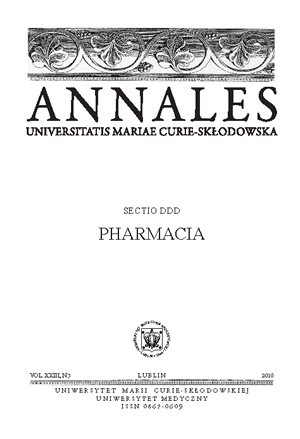Izomeraza fosfoglukozowa z Escherichia coli ATCC 25922- badania pilotowe
Słowa kluczowe:
izomeraza fosfoglukozowa, izoenzymy, inhibitory PGI, Escherichia coli ATCC 25922, biofilmAbstrakt
Fosfoglukoizomeraza (EC 5.3.9.1; PGI) jest enzymem uczestniczącym w metabolizmie cukrów, katalizującym odwracalną izomeryzację D-glukozo-6-fosforanu i fruktozo-6-fosforanu. Odgrywa kluczową rolę w procesie syntezy in vivo zewnątrzkomórkowych polisacharydów (EPS) tworzących bakteryjny biofilm. Pełne zrozumienie mechanizmów katalizy i inhibicji PGI może skutkować odkryciem nowych inhibitorów PGI – leków przeciwbakteryjnych.
W pracy opisano procedurę częściowego oczyszczania PGI z frakcji cytozolowej E. coli ATCC 25922. Aktywność enzymu mierzono w kierunku od D-fruktozo-6P do D-glukozo-6P. Rozdzielono dwie formy (izoenzymy I i II) tego enzymu. Badano wybrane właściwości formy dominującej (izoenzymu I) PGI. Stała Michaelisa dla D-fruktozo-6P wynosiła 1 mM. Enzym miał optymalną aktywność w buforze TRIS/HCl, pH 7.65. Ciężar cząsteczkowy fosfoglukoizomerazy wynosił 120 kDa. Nasze wyniki wskazują na obecność aminokwasów: cysteiny, tryptofanu, tyrozyny i lizyny w centrum aktywnym PGI z E. coli ATCC 25922. Brak hamowania aktywności charakteryzowanego enzymu przez chelatory takie jak: EDTA, 1,10-fenantrolinę i TRIS dowodzi, że PGI nie jest metaloproteiną. Zaobserwowano duże podobieństwo właściwości pomiędzy izomerazami fosfoglukozowymi izolowanymi z E. coli ATCC 25922 i z innych szczepów E. coli takich jak: K10 i ATCC 35218.
Bibliografia
1. Bachman B.J.: Linkage map of Escherichia coli K-12, edition 7. Microbiol. Rev., 47, 180-230.
2. Bradford M.M.: A rapid and sensitive method for the quantitation of microgram quantities of protein utilizing the principle of protein dye binding. Anal. Biochem., 72, 248-254, 1976.
3. Davies C. et al.: The structure of human phosphoglucose isomerase complexed with
a transition-state analoque. Acta Crystallogr. Sect. D Biol. Crystallogr., 59, 1111-1113, 2003.
4. Davis B.: Disc electrophoresis. II Method and application to human serum proteins. Ann N.Y. Acad. Sci., 121, 404-407, 1964.
5. Froman B.E. et al.: Isolation and characterization of the phosphoglucose isomerase gene from Escherichia coli. Mol. Gen. Genet., 217, 126-131, 1989.
6. Fraenkel D.G., Levisohn S.R.: Glucose and gluconate metabolism in an Escherichia coli mutant lacking phosphoglucose isomerase. J. Bacteriol., 93, 1571-1578, 1967.
7. Friedberg I.: Localization of phosphoglucose isomerase in Escherichia coli and its relation to the induction of the hexose phosphate transport system. J. Bacteriol., 112, 1201-1205, 1972.
8. Hansen T. et al.: Cupin-type phosphoglucose isomeraes (Cupin-PGIs) constitute a novel metal-dependent PGI family representing a convergent line of PGI evolution.
J. Bacteriol., 187, 1621-1631, 2005.
9. Hansen T. et al.: Bifunctional phosphoglucose/phosphomannose isomerase from the Archaea Aeropyrum pernix and Thermoplasma acidophilum constitute a novel enzyme family within the phosphoglucose isomerase superfamily. J. Biol. Chem., 279, 2262-2272, 2004.
10. Hua Q. et al.: Response of the central metabolism in Escherichia coli phosphoglucose isomerase and glucose-6-phosphate dehydrogenase knockouts. J. Bacteriol., 185, 7053-7067, 2003.
11. Ishaque A. et al.: On the absence of cysteine in glucose 6-phosphate dehydrogenase from Leuconostoc mesenteroides. Biochem. Biophys. Res. Commun., 59, 894-901, 1974.
12. Jeffery C.J.: Moonlighting proteins. Trends Biochem. Sci., 24, 8-11, 1999.
13. Lever M.: A new reaction for colorimetric determination of carbohydrates. Anal. Biochem., 47, 273-279, 1972.
14. Mathur D., Garg L.C.: Functional phosphoglucose isomerase from Mycobacterium tuberculosis H37Rv: rapid purification with high yield and purity. Protein Expr. Purif., 52, 373-378, 2007.
15. Noltmann E.: Aldose-ketose isomerases. [In] Boyer P., editor. The Enzymes, 6, 3rd edn. New York: Academic Press, 271-298, 1972.
16. Schreyer R., Böck A.: Phosphoglucose isomerase from Escherichia coli K10: purification, properties and formation under aerobic and anaerobic condition. Arch. Microbiol. 127, 289-298, 1980.
17. Swatko M., Szumiło T.: Isolation and partial characterization of a novel ribitol dehydrogenase from mycobacteria. Ann. UMCS, Sect. DDD, XII/XIII, 169-178, 1999/2000.
18. Szynal K.: Purification and evaluation of biological role of phosphoglucomutase (PGM) and phosphoglucoisomerase (PGI) from bacteria cells of Escherichia coli. Master’s thesis. Medical University of Lublin, 2008.
19. Thomas A.D.: Partial purification and characterization of glucose-6-phosphate isomerase from Dictyostelium discoideum. J. Gen. Microbiol., 24, 403-407, 1981.
20. Verhees C. et al.: The phosphoglucose isomerase from hyperthermophilic archaeon Pyrococcus furiosus is a unique glycolytic enzyme that belongs to the cupin superfamily. J. Biol. Chem., 276, 40926-40932, 2001.
21. Weeden N.F.: Genetic and biochemical implications of the endosymbiotic origin of the chloroplast. J. Mol. Evol., 17, 133-139, 1981.
Pobrania
Opublikowane
Numer
Dział
Licencja
Prawa autorskie (c) 2025 Autorzy

Praca jest udostępniana na licencji Creative Commons Attribution-NonCommercial-NoDerivatives 3.0 Unported License.


